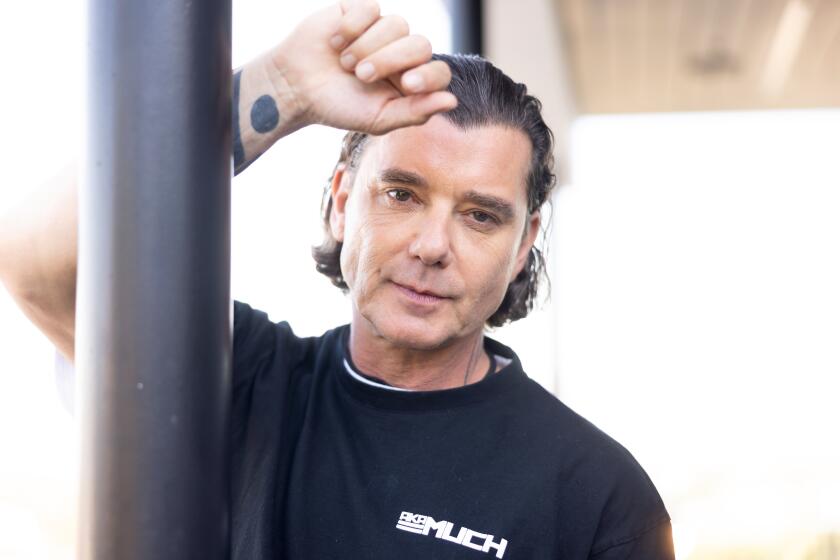Worldwide Influence : Spain Meets Greece, Mexico and Other Lands in ‘Navidad Flamenca’
- Share via
If a depiction in flamenco of the birth of Jesus seems an unlikely mix, the diversity of Dance Espana’s “Navidad Flamenca”--coming to Fullerton tonight and to Costa Mesa Dec. 12--doesn’t stop there: The show combines Middle Eastern costumes, a Greek chorus, New Mexican folk lyrics, medieval ecclesiastical drama, ancient Hebrew rituals, Spanish songs and English narration by angels.
And then there’s the flamenco itself.
“Flamenco is influenced by Hindu, Moorish, Sephardic, Gypsy and Spanish traditions,” explained Dance Espana choreographer and artistic director Pablo Rodarte on the phone from his home in Albuquerque. “Its roots are in Andalusia and the Inquisition, when Isabella and Ferdinand ousted the (non-Christians) from Granada in 1492. The persecuted people--the Moors, the Jews and Gypsies--did the flamenco.
“True art only comes out of persecution. That’s why the blues in America is so great.”
And the Hindu part?
“The Hindu influence can be seen in the symbolic arm movements.”
“Navidad Flamenca,” once described as “a sensual presentation of a mystical experience,” is a pageant-like interpretation of events drawn from the Gospels of Luke and Matthew. It explores the feelings and conflicts of Jose and Maria--that’s Joseph and Mary--and the bond between Maria and her cousin Elizabeth. The Magi and angel Gabriel also figure in the story.
“It’s a pretty eclectic show,” Rodarte agreed. “It’s like a musical, like Broadway. But I come from background of theater. Anything strange to most people is normal to me.”
Indeed, the 47-year-old’s life has been as diverse as the show itself. He studied ballet in Denver, his hometown, left for Spain in 1965 and stayed 10 years on his first trip and 24 years in all. His grandparents on both sides are Mexican. He danced with a flamenco trio in Australia and with the Jose Greco and Maria Benitez companies. Although most flamenco dancers are, as he says, “just flamenco,” he has been involved with all kinds of theater.
“Many purists would label me dilettante,” he notes in his introductory program remarks, “but then again, I am an American.”
His 17-member touring company includes dancers Eva Encinias-Sandoval and Paco Antonio; singers La Conja from New York and Manolo Segura from Jaen, Spain; and Gypsy guitarist Chuscales from Granada. John Bartlit and Daniel play wind and percussion instruments that include shawms, rain sticks, dry palm leaves, oud and ram’s horn. “The musicians each have 10 arms,” Rodarte said. “One plays the drum while he’s playing the flute!”
*
Rodarte conceived “Navidad Flamenca” as a moneymaker for his troupe. “Everybody in the country has a ‘Nutcracker,’ ” he noted, “and we also wanted a Christmas show that could bring in revenue.” Four years later, he continues to sew most of the costumes himself. He nevertheless believes that the more people who see the show, the better his chances of attracting funding for other projects.
Such as?
“Bram Stoker’s ‘Dracula,’ set in Baroque Spain, danced as a bolero.”
In the meantime, there have been rewards.
“I got so many calls from people who, after seeing the show, said they went back to their faith! ‘After seeing the show, I found my light,’ and so on. How inspired they were!
“I am a Christian. But I don’t want to limit my audience to Christians. Jews and Muslims love this show too. It’s a spectacle, a wonderful spectacle. I don’t feel I’m on a mission.”
* Dance Espana will present “Navidad Flamenca” tonight at 8 in the Louis E. Plummer Auditorium, 201 E. Chapman Ave., Fullerton ($10-$15. (714) 773-3371) and Dec. 12 at 2:30 p.m. in the Robert B. Moore Theatre at Orange Coast College, 2701 Fairview Road, Costa Mesa ($15-$19; $12-$16 in advance. (714) 432-5880).
More to Read
The biggest entertainment stories
Get our big stories about Hollywood, film, television, music, arts, culture and more right in your inbox as soon as they publish.
You may occasionally receive promotional content from the Los Angeles Times.










